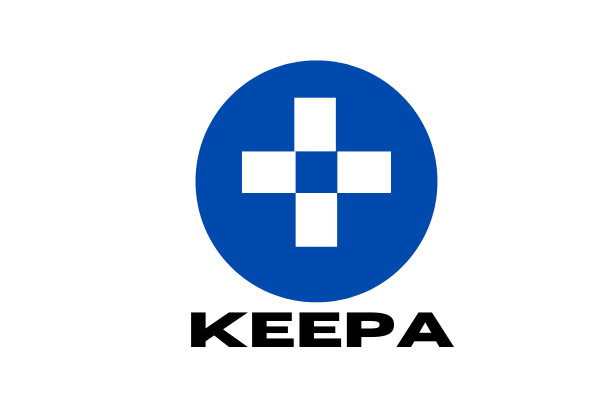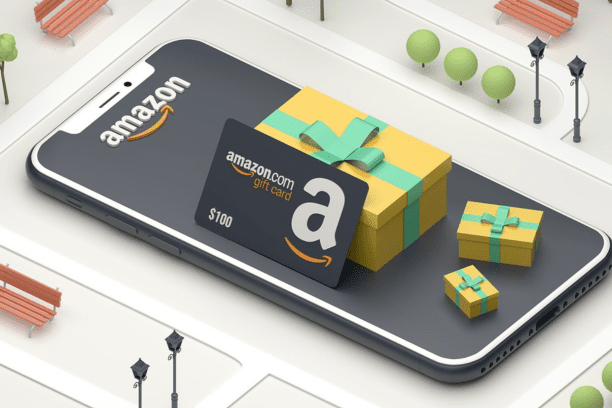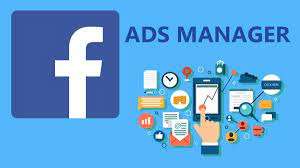
For many small businesses, Facebook is an important sales channel. Advertising on the social media platform allows you to reach a large number of potential customers with a very cheap advertising spend, since it has approximately three billion monthly active users.
The sole issue? It can be intimidating to open Facebook Ads Manager for the first time. Run a new ad campaign seems complex because of the abundance of ad format possibilities, audience intelligence tools, and data dashboards.
We’ll go through how to set up an ad account and utilize it to manage campaigns successfully in this article. If you use Shopify, you may manage campaigns, synchronize your product catalog, and get performance reports in one location by adding Facebook as a marketing channel in your Shopify dashboard.
Table of Contents
What is Facebook Ads Manager?
The tool for purchasing Facebook and Instagram advertising spots is Facebook Ads Manager. To manage campaigns on the advertising network, Facebook Ads Manager is utilized by over 37.3 million organizations.
Ads manager key features
The network is so popular that in the second quarter of 2021, ad spend topped $5.5 billion. Facebook and Instagram, both of which are owned by Meta, represented for 23.8% of the total revenue earned by digital ads in the year.
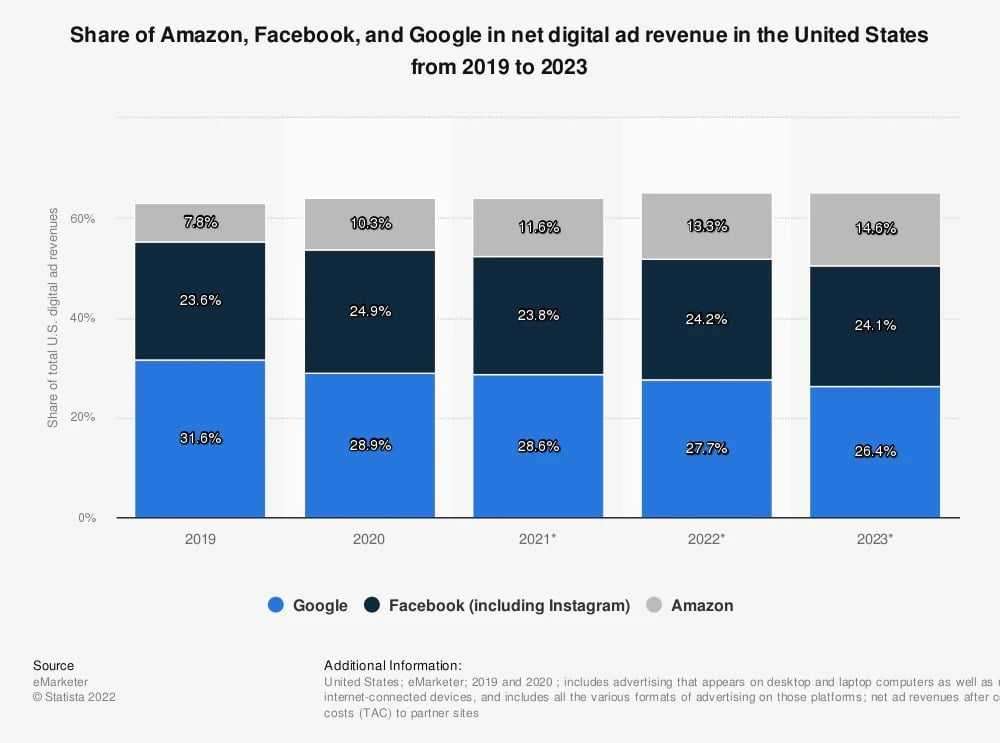
Advertisers using Ads Manager can take advantage of the following capabilities to promote their businesses:
- Suite Meta Business. Get a summary of all the activity on both your personal and business Facebook and Instagram accounts without having to log in.
- Manager of Audience. Save a custom audience that you created with Facebook members’ age, location, hobbies, and occupation in mind. Additionally, you may add email subscribers, customer lists, and data to retarget those who have already interacted with your business.
- pixel meta. The Meta pixel correlates Facebook user activity with what’s happening on your page. Run retargeting ads using this data, such as for those who have visited within the last 30 days or who have added an item to their online cart but have left the site without making a purchase.
- Events Manager: This subset of the Meta pixel allows you to track in-person sales and visits to your store. It improves the accuracy of advertising reporting, especially if your aim is to drive foot traffic to a store. Creative Hub: Previously called the Creative Studio, this feature allows advertisers to create mock ad creatives before pushing them to a campaign. It also allows you to preview your creatives across multiple devices, get team member feedback, and see competing ads from competitors.
How to open an Ads Manager account
Are you prepared to begin running Facebook ads? Creating a Facebook Ads Manager page is explained here.
Establish a company page on Facebook. You will need to use a personal account for this, but after the Facebook page is created, you can modify the permissions.
Launch the Meta Business Suite (formerly known as Facebook Business Manager) app. To access Ad Accounts, navigate to Meta Business Settings > Accounts.
Pick Make a New Advertising Account.
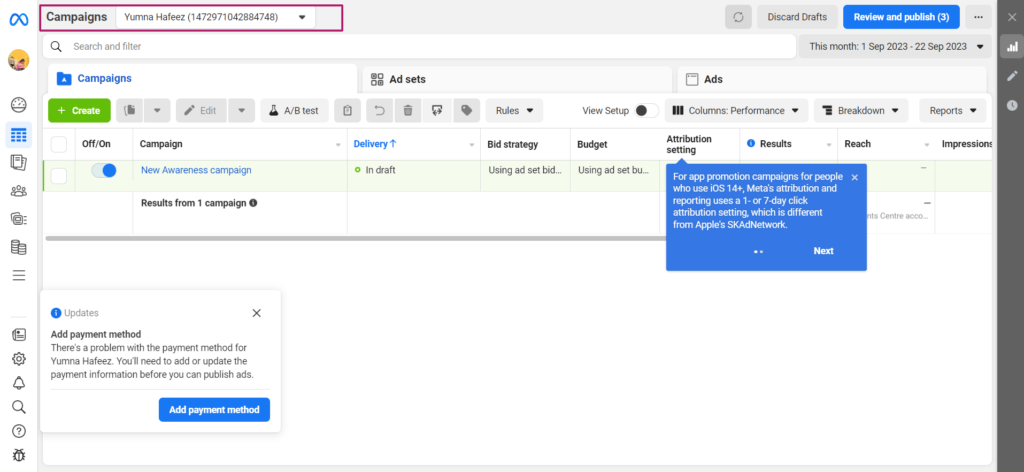
After naming your advertising account, select your currency and time zone.
Ask your team to collaborate on your new ad account, granting them either complete or limited authority (e.g., the ability to make new ads but not modify the ad account settings).
How to run campaigns using Facebook Ads Manager
- Decide on a campaign’s goal.
- Select a performance objective and decide on a conversion location.
- Make a timetable and a budget.
- Create a following
- Select a platform for your ad placement.
- Develop the creative for your advertisement.
- Examine advertising campaigns and release
Facebook advertising terminology
Prior to navigating this course, it’s beneficial to be familiar with the jargon used in Facebook advertising. Three tiers are created by the Ads Manager for new campaigns:
- Ads. Decide on the campaign’s overarching goal, such as engagement, website clicks, or conversions. Pick a campaign name that expresses this objective.
- Ad groups. Decide who you want to see your advertisements shown in front of as your target audience. For every campaign, you can make many ad sets and give each one a different budget. For example, if your main objective is to increase conversions, you may allocate 60% of the campaign budget to an ad set that targets women and the remaining 40% to an ad set that targets men.
- advertisements. You will create your advertisement creative here. Once more, an ad set can contain multiple adverts. Try different Facebook ad formats to determine which ones your audience responds to the best.
The Structure Facebook ads manager .

1. Set a campaign objective
Clicking the bright green “Create campaign” button in the upper left corner of the Facebook ads screen is the first step in the creation process. Next, decide on a goal. This serves as the campaign’s main objective and determines who the advertising algorithm displays your adverts to.
Choices consist of:
- Awareness of brands
- Engagement with traffic (such as page likes or video views)
- Sales
- lead generation,
- app marketing
The Facebook ads manager of choosing a campaign objective

Sydney So Sweet, a childrenswear shop, began Facebook advertising with conversions as its main objective. Jen Greenlees, the company’s CEO and owner, claims that this was too naive. Since we increased the scope of our advertising to include engagement optimization, our Facebook account has grown exponentially overall.
It’s simple for store owners to become fixated on raising sales as their main objective, but by boosting Facebook interaction overall, we have seen an even higher return on our conversion advertisements.
2. Set a conversion location and choose a performance goal
Next, give your campaign a name and indicate whether you fit into any of Meta’s “special ad categories.” Determine whether you want to use Meta’s “Advantage campaign budget” spending option and whether you want to conduct any A/B testing.
Ads Manager will next ask you to select where you want to direct traffic—for example, to your website, app, or Facebook page for your company.
For the campaign’s engagement, traffic, sales, and lead generation goals—but not for app promotion or awareness—you will choose a conversion location.
Next, decide on a performance objective (such as increasing the quantity of conversions) and, if asked, set up a Meta pixel.
3. Set a budget and schedule
A lot of inexperienced marketers are afraid about going over their advertising budget. To combat this, give your campaigns start and end dates and choose one of the following budgeting options:
- daily spending plan.
- lifetime spending plan. The total amount that you wish to spend during the course of the campaign. Because Facebook’s algorithm will use parts of the budget when it thinks it’s best, your daily ad expenditure may vary.
The Facebook ads manager of campaign budget option.
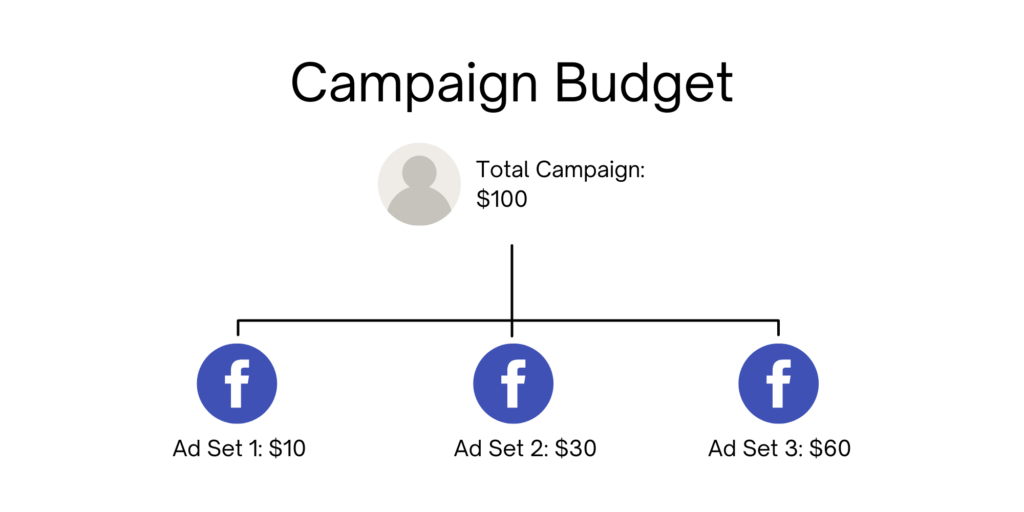
The tricky one is: How much money should you set aside for Facebook advertisements? Experts like Smart Marketer creator Ezra Firestone advise allocating between 10% and 30% of your store’s earnings for investments. For instance, if you make $100, you should reinvest between $10 and $30 in Facebook advertising.
The flexibility to spend as much or as little as you desire is what makes Facebook advertising so attractive. The engine can run on just $5 a day.
You can run an advertisement for three days, assess its performance, and then run a fresh one for three days using this ad budgeting technique. For a monthly fee of just $5, you can create ten distinct ad variations, totaling $150.
Keep in mind that you’re not just paying money to get clients when you’re budgeting for Facebook advertisements. Additionally, you’re paying money to purchase audiences of people who have visited your website, viewed your video, or joined your email list, among other non-customer-facing brand assets.
Facebook advertising, according to Ezra, “is one of those things where you’ve got to be willing to consistently spend over time,” because of this.
4. Build an audience
Next, use one of the following options to specify the kind of person you want to see your campaign for.
Custom audiences
Create a saved audience if you’re starting a Facebook advertising campaign from scratch. Include the characteristics and demographics that your target market possesses, like their:
- Gender
- Age
- Location
- Language
- Hobbies and interests
The Facebook ads manager Of custom audience.

The estimated size of the audience is displayed in the right-hand column. Start broad and then narrow down your ad targeting after you start gathering data.
You may discover after two weeks that your campaigns are more effective with those in their 50s and 60s than with those in their 40s and 50s. In that scenario, it would be prudent to reoptimize your campaigns, either by splitting the ad set into two and allocating more funding to the higher-performing one, or by eliminating the underperforming age group.
Lookalike audiences
An audience that resembles an existing list in some way is called a lookalike audience. With the help of the algorithm, you can target Facebook users who have similar attributes to your current clients in future advertisements.
Anybody who purchases from you online is automatically added to a database by Shopify. Upload this list to the Audience Manager in order to achieve your sales target.
Decide how similar you want the new audience to be. A 1% lookalike is the closest match to your current customer base, while a 10% overlap widens the field to reach a larger audience.
facebook ads manager Lookalike audiences
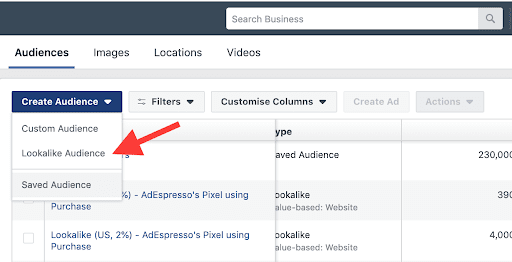
Retargeted audiences
Facebook already has a record of who has seen your products thanks to the pixel that you have placed on your website. Add these folks to an audience for retargeting.
Shopify retailers may connect their catalogs to Instagram and Facebook. You can then choose to run dynamic product advertisements. The product that they have already been observing will be displayed by the algorithm, serving as a last-ditch reminder to buy before they forget about it.
According to James Eaglesfield, an Autoweb Design digital marketing professional, “Dynamic ads can target website visitors who fell short of completing a purchase.” The product and a few alternatives that are similar to it will be displayed to them in your advertisement. You shouldn’t give up on these prospects since they are hot leads, and one more prod could be all it takes to close the deal.
Consider the following McBride Sisters Collection Facebook advertisement. The company launched a campaign to retarget its existing customer base. Online sales increased by 58% as a result.
5. Choose a platform ad placement
Businesses can advertise goods and services on Facebook and Instagram by using Facebook Ads Manager. Under the Placements tab of Ads Manager, select the platform on which you wish to run your advertisement.
By default, automatic placement is enabled. In this configuration, the advertising algorithm determines which placements will best help you achieve your goal while making the most of your available budget. If you’re not sure which platforms or placements will be most effective for your target demographic, here is a fantastic place to start.
Alternately, choose locations and platforms by hand. Select from:
- Facebook features include the feed, marketplace, video feeds, in-stream videos, right column, Facebook Stories, search results, and messenger.
- Instagram: Reels, Stories, Feed, Explore page, Instagram Shop, and in-stream videos
- Audience Network: Outside programs and websites that “rent” Facebook’s advertising space
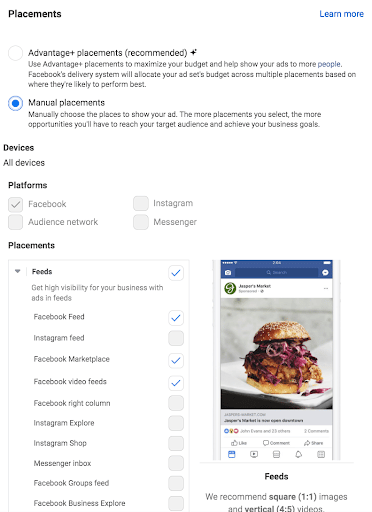
6. Build your ad creative
The ad design is arguably the most crucial component of any Facebook advertising plan. The appearance of your advertisements has a big influence on how likely consumers are to accomplish your objective. In a busy feed, people won’t interact with an advertisement if it doesn’t catch their eye.
Because of this, JOI CEO Hector Gutierrez advises, “Modify the appearance of your advertisement. When people see the same advertisements all the time, they burn out. To increase engagement, make a series of advertisements for the same campaign and alter the colors and visuals on a single offer.
“Ads must be captivating and memorable, and when you bombard your audience with the same ones, they lose both of these qualities.”
Choices consist of:
- Video ads
- Single image ads
- Carousel ads
- Canvas ads
Before launching the campaign, check out the creative for your ads in the format of your choice. Specifications for Facebook ads vary by device. Artists must have a visually appealing appearance on tablets, PCs, and smartphones.
7. Review campaigns and publish
Examine the data you’ve already added before releasing your new Facebook ad campaign. You should employ photos, videos, and ad copywriting that effectively communicate your campaign’s message to the Facebook users it will target.
Once all the components are satisfactory to you, submit the campaign for approval. Facebook usually reviews and approves ads within a few hours, but it can take up to 24 hours in total.
How to report on ad performance with Facebook Ads Manager
After you’ve launched your first campaign, your work is far from done. Track the effectiveness of your ads to see whether they are spending money or achieving their objectives.
Open Ads Manager and locate the Account Overview tab. A campaign performance reporting dashboard will be displayed to you. To access specific reports for every ad set and ad creative, click through each one.
Click the menu dropdown to choose from a pre-made reporting dashboard or to highlight the key performance indicators that your company is monitoring.
Not sure how to apply this knowledge? Among the best methods for reporting on Facebook ads are:
- Divide up your information. By segmenting your data dashboard based on day, time, activity, or delivery type, you can see when conversions are occurring. Take it out of the ad set if it isn’t working out.
- Conduct A/B experiments. According to Savannah Sanchez, the creator of The Social Savannah, “I think the only way to scale an ad account is having a volume of effective ad creatives.” It has nothing to do with deranged strategies or media buying hacks. It all comes down to conducting weekly creative testing and analyzing the results to determine what functions well and poorly.
- Advertise for a minimum of two weeks. The ad platform may now optimize as a result. Keep an eye on the buys and click-through rate. This will help you decide whether to continue running the advertisement, increase your investment, or scale it.
Recall that although closing a deal is the ultimate aim, it may not happen immediately. Be not demoralized. To find out if people are seeing your advertisement and, more crucially, if they are interested enough to click on it, look at other data points like reach and click-through rate. Those indicate that you’re headed in the right direction.
Although Facebook Ads Manager offers sophisticated reporting features, the data displayed within your account are not entirely precise. In 2021, Apple updated iOS14, limiting the amount of data that advertising may get.
Fuse Lenses CEO and co-founder Brandon Dill claims that the update prevented Facebook from tracking the effectiveness of their advertisements on iPhone users. That accounts for 70% of our clientele.
“We take the percentage of customers who said they found us on Facebook in our survey and assume that all of the revenue on our site came from the same percentage of Facebook customers,” explained Brandon, ingeniously circumventing the now-defunct advertising metric.
“To obtain a total Facebook sales attribution, we multiply the total sales by the percentage of Facebook customers. Then, to calculate [return on ad expenditure], we divide that amount by our entire Facebook spend.
Fuse Lenses has returned to profitability since using this workaround, according to Brandon: “It takes a little bit of work to report these numbers manually—takes about five minutes—but the juice is worth the squeeze on this one.”
Use Shopify in place of Facebook Ads Manager
Facebook is a major component of many small businesses’ marketing strategies. Master your marketing strategies to gain access to the social media feeds of your target audience, which is likely to lead to purchases.
There is a workaround if Facebook Ads Manager seems overly complicated. By adding Facebook as a marketing channel to your Shopify dashboard, you can connect your product catalog, manage campaigns, and get performance reports all in one location.
The finest aspect? By integrating Shopify with Facebook, you can offer in-app checkout, establish social media stores, and take payments with just one click with Shop Pay. Each gets rid of a typical barrier that customers have before making a purchase on Facebook.



